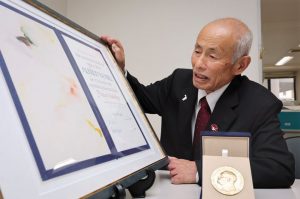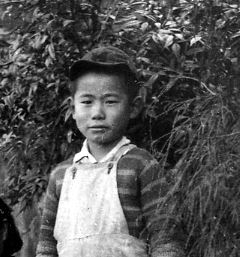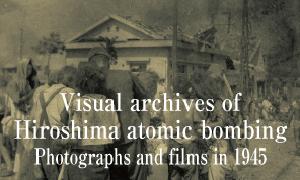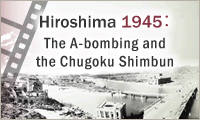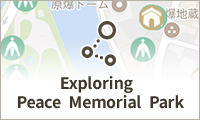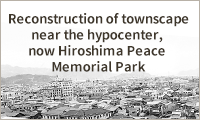Survivors’ Stories: Toshiyuki Mimaki, 83, Kitahiroshima-cho, Hiroshima―Thinking of his predecessors, he begins A-bomb survivors’ movement
Aug. 4, 2025
He kept walking across ruins of Hiroshima, tightly holding his mother’s hand
by Kana Kobayashi, Staff Writer
Toshiyuki Mimaki, 83, has spoken about the horrors of the atomic bombing and has called for a “world without nuclear weapons” both in Japan and abroad as chair of the Hiroshima Prefectural Confederation of A-bomb Sufferers Organizations (Hiroshima Hidankyo). He was exposed to radiation at the age of three when he entered Hiroshima with his mother and his younger brother soon after the bombing in search of his father. He has been at the forefront of efforts to carry on the will of deceased predecessors who built up the A-bomb survivors’ movement.
In August 1945, Mr. Mimaki was living with his parents and younger brother in the village of Imuro (now part of Hiroshima’s Asakita Ward), about 17 kilometers from the hypocenter. Earlier that same year, they had been living in Tokyo, but after the Great Tokyo Air Raid in March, they moved to Hiroshima, his father’s hometown.
On the morning of August 6, Mr. Mimaki was playing in front of his home when a flash of light appeared. In the afternoon, he saw lines of people streaming from the direction of Hiroshima. They were in terrible condition, their hair disheveled and their clothes tattered or burned. Mr. Mimaki’s father worked for the Hiroshima Railway Bureau and commuted to Hiroshima from the former Aki-Imuro Station on the Kabe Line. On August 7, when he did not return home, Mr. Mimaki, his mother, and his younger brother were given a ride on a truck to head toward Hiroshima. In the city center, which had been reduced to ashes, he just kept walking, tightly holding his mother’s hand.
A few days later, his father returned home safely. He had been exposed to the A-bombing near Hiroshima Station (now in Minami Ward), but escaped serious injury. He rarely spoke about what he saw or experienced that day. Mr. Mimaki said, “That’s because he was deeply distressed after losing many of his colleagues.” He spoke with great consideration for his father. As a child, he was absent from school for about four months due to his poor health, which might have been a result of the A-bombing.
Mr. Mimaki worked for a company while attending high school part-time. Around 2005, he began to devote significant effort to the A-bomb survivors’ movement. Drawing on his experiences as a town councilor and PTA president, he was appointed chair of the A-bomb survivors’ group in Kitahiroshima-cho. Later, he met the late Sunao Tsuboi, former chair of Hiroshima Hidankyo, and other members, and learned about the achievements of the late Ichiro Moritaki, the organization’s first chair, and his colleagues.
His first overseas visit was to New York, where the Nuclear Non-Proliferation Treaty (NPT) Review Conference was held in 2010. There, he joined a demonstration march with about 10,000 citizens from around the world, who were calling for a world without nuclear weapons, and he shared his experience of the A-bombing with local high school students. He strengthened his resolve: “I want to fulfill my mission as an A-bomb survivor by calling for a world without nuclear weapons based on my own experience.”
Last year, an event occurred that became part of the history of the A-bomb survivors’ movement. The Nobel Peace Prize was awarded to the Japan Confederation of A- and H-Bomb Sufferers Organizations (Nihon Hidankyo), a national organization co-chaired by Mr. Mimaki. He received a certificate at the award ceremony in Oslo, Norway. “It felt heavy,” he said. Thinking of his predecessors who had paved the way for the movement, he once again reflected on the roles they had played.
Even now, there are about 12,000 warheads in the world, and wars continue to break out. With a sense of urgency about these global conditions, Mr. Mimaki urges the younger generation to stand firmly against nuclear weapons and war, reminding them that while nations create nuclear weapons and wage wars, it is ordinary citizens who become their victims.
(Originally published on August 4, 2025)

